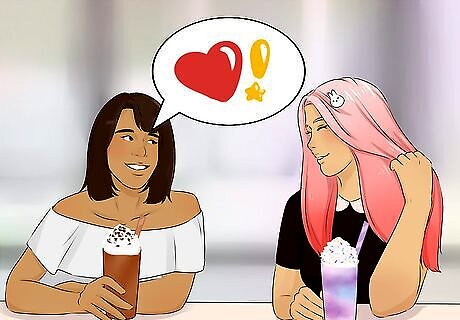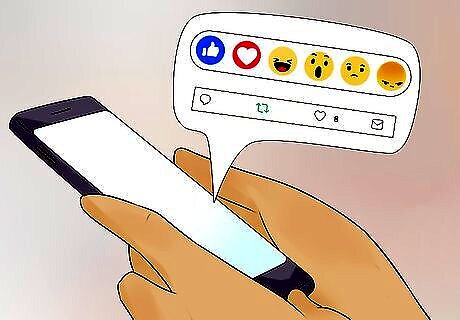
views
Talking to People

Hype yourself up beforehand with positive talk. Before you approach someone or attend a social function, give yourself some positive self-talk. Tell yourself that you have many wonderful qualities and that someone out there will be lucky to have you. For example, you might say, “You’re a great person! There’s someone out there for you.” Avoid self-defeating talk, like “no one is ever going to be interested in me” or “I’ll look like a fool.” Reframe your thoughts to be neutral or positive, such as “I will never know unless I try” or “there’s someone out there for me. I just have to find them.” Remind yourself that getting rejected isn’t the end of the world. Whenever you find yourself thinking, “What if I get rejected?” force yourself to say or think “So what?”

Prepare a question or opening before approaching the person. Think of a casual question or line to open the conversation. Instead of pick-up lines, however, think of a comment about something going on around you. For example, talk about the weather, music, or drinks. For example, if you’re at a bar and there’s a TV playing, make a comment about what is on the television. You might say, “I can’t believe the referee made that call” or “have you seen this film? It’s one of my favorites.” Sometimes, people wear clothing that show their interests. For example, they may wear a band T-shirt or have anime pins on their bags. These are a great opening for conversation. You might say, “I just saw your jersey, and I have to say, I’m a fan of that team too.”

Wait for their response. If the other person is interested in talking, they will continue the conversation with you. They may ask a question or share a story. This is a sign that you can continue the conversation. If they respond with a 1-word answer like “cool” or “yeah,” they may not be interested in talking. That’s okay. Step back and try again with someone else.

Focus on the other person, not yourself. Try not to obsess over what you’re saying or doing. Instead, devote your full attention to the other person. This will help prevent you from worrying about how you’re presenting yourself. As you talk to the other person, show them that you are answering by nodding your head, giving verbal feedback like “mm-hm” or “interesting,” and asking them questions. Mindfulness techniques can help with this. Try to notice little things about the other person, such as the color of their eyes, their smile, or their hand gestures.

Stay calm during lulls in the conversation. All conversations have pauses and lulls. This doesn't mean that you're doing something wrong or that the other person is bored. Let a moment or 2 pass in silence. If you want, bring up a new topic or ask the other person a question. Take a deep breath. Ground yourself by focusing on the environment around you. Try not to assume what the other person is thinking. This lull might be a great time to offer to get them a drink, make a joke, or ask them about their job or interests. If the conversation truly seems to have fizzled out, thank the other person and tell them that it was great chatting. If you want, ask them for their number or see if they want to meet up again.

Compliment the other person if you are interested in them. If the conversation continues naturally and you like the other person, you might try giving them a genuine compliment. Avoid making crude or crass comments. Instead, give sincere comments about their character, interests, or stories. Tailor your compliments to the type of conversation you’re having. For example, if they just shared a story about skydiving, you might say, “Wow, that’s so cool. You’re really brave to do that.” If you share interests with the other person, you might let them know that you like that about them. You can say, “You’re so cool. I’ve never met someone who is also interested in electro swing.” It is okay to compliment someone’s looks, as long as the comment is tasteful. You might compliment their hair or clothing, or you can say something simple like, “I hope this doesn’t come off too strong, but I think you’re very pretty.”

Avoid negative or critical statements. While a little bit of self-deprecating humor can be charming, avoid criticizing yourself or the other person while you chat. Take this time to express your positive qualities. For example, don’t say something like, “I know you’re probably not interested in me, but can I have your number?” This can set the wrong tone for the conversation. If you want their number, simply say, “It was great talking to you. Would you mind if I asked for your number?” Avoid being complaining too much as you talk. For example, if someone asks you about your job, don’t say, “I hate it there so much. My boss is such a jerk.” Try to be more neutral. For example, you can say, “I work at the store. It pays the bills.”

Cut off the conversation after about 10-15 minutes. In most cases, this is the perfect length to get to know someone without monopolizing their time. When the conversation starts to fizzle, thank the other person for their time. If they seem interested in you, ask for their number or contact information. For example, you might say, “It was so great talking to you tonight. I would love to continue this conversation over coffee some time.” If the other person agrees, ask for their number. This practice works especially well if you are flirting with a stranger or someone you just met. If you've known the person a while, you may continue the conversation longer. If you and the other person are really making a connection, you don’t have to end the conversation. In fact, in some cases, if you can keep up the conversation with enthusiasm, it may be a sign that you are a good match.
Using Body Language

Keep your shoulders back for an open body posture. As nervous as you might feel, try not to show it. Don’t cross your arms, look at the ground, or clench your hands. Instead, force yourself to keep your shoulders back and your arms free. This will make you look and feel more confident.

Control your breathing if you start to feel anxious. If your heart or breathing starts to speed up, take a deep breath and try to slow your breathing down. Inhale deeply into the bottom of your stomach. If you need to, excuse yourself to the bathroom or outside for a minute to calm down.

Smile and laugh. The best way to show you’re interested in someone is to demonstrate how happy or excited they make you. A simple, genuine smile can go a long way in catching someone’s eye. If they make a joke, laugh. Don’t be afraid to show your enthusiasm about a subject or conversation. People generally enjoy it when others are cheerful while they flirt. Laughter is a great way to release tension. It can help you relax if you're starting to feel overwhelmed.

Measure their interest by watching their body language. If the other person is interested in you, they may lean into the conversation, play with their hair, or touch your arm. They will face you with an open body posture. They may mirror your posture as well. These are all signs that they are enjoying the conversation! If someone displays these signs, you might try complimenting them or eventually asking for their number. Alternatively, if they turn away from you, stop making contact, or cross their arms, they may not be interested in chatting. Simply thank them for their time and move on. Pat yourself on the back for trying! Body language isn't an entirely reliable way to judge attraction. The other person may be having a good time without being interested in you romantically. That's okay! Just remind yourself that they still found you to be interesting and exciting.

Make eye contact with the person. Eye contact is a powerful tool. Keep contact for 1-3 seconds before glancing away. If the other person makes similar eye contact back, it may be a good sign. Making eye contact with someone across the room is a subtle way to show that you’re interested. If you find them looking back, it may mean that you can approach them. Eye contact alone does not mean that the other person is interested in you. If you find someone making eye contact with you, look for other body language signs before making a move.
Gaining Confidence

Practice flirting with people every day. Flirting is a skill, and like any skill, it requires practice. Try some mild flirting every day with someone new. Talk to the cashier at the grocery store, make a joke to someone on the bus, or go out to a bar after work.

Meet people through online dating. If you’re not quite ready to flirt with people in real life, online dating can help you practice your moves. Flirt with people through the chat function by discussing your interests, complimenting them, or using fun emojis. If online dating works out, you can meet the person in real life. It may be easier to flirt with them in person since you have already spoken for a while. Online dating can also help you learn how to handle rejection. You might find that not everyone will answer, and that’s okay.

Celebrate whenever you flirt with someone. Even if you weren’t successful in getting their number or date, praise yourself for trying. Remind yourself that you took a big step and encourage yourself to keep going. If you still feel nervous or anxious after the incident, try exercising or taking a walk. This can help you process the events and work out your nerves. The first time you flirt with someone, give yourself a reward, like dessert or a new video game.

Avoid dwelling on rejection. Rejection happens to everyone, and it doesn’t mean that there is something wrong with you. There are many reasons why someone may not want to flirt back. Instead of thinking about the rejection, focus on how brave and confident you were when you flirted with them. Tell yourself, “I can always try again with someone else.” As hard as it may seem, don't analyze what happened during the encounter. If you find yourself replaying it in your head, go do something that will keep you busy, such as exercising or talking to a friend. If you really like someone who wasn’t interested in you, try to encourage yourself to move on. Remind yourself that there are plenty of other wonderful people in the world.

Treat your social anxiety with the help of a mental health professional. While you can date and flirt with social anxiety, many of the underlying causes won’t go away unless you are in treatment. If you’re not already seeing a psychologist or therapist, try finding 1. They may treat your social anxiety with cognitive behavioral therapy, medication, or a combination of both. Talk to your therapist about your concerns with flirting and dating. They may be able to coach you through these interactions. When you're ready, they may even suggest a group setting for your therapy to help you get more comfortable with these interactions.




















Comments
0 comment